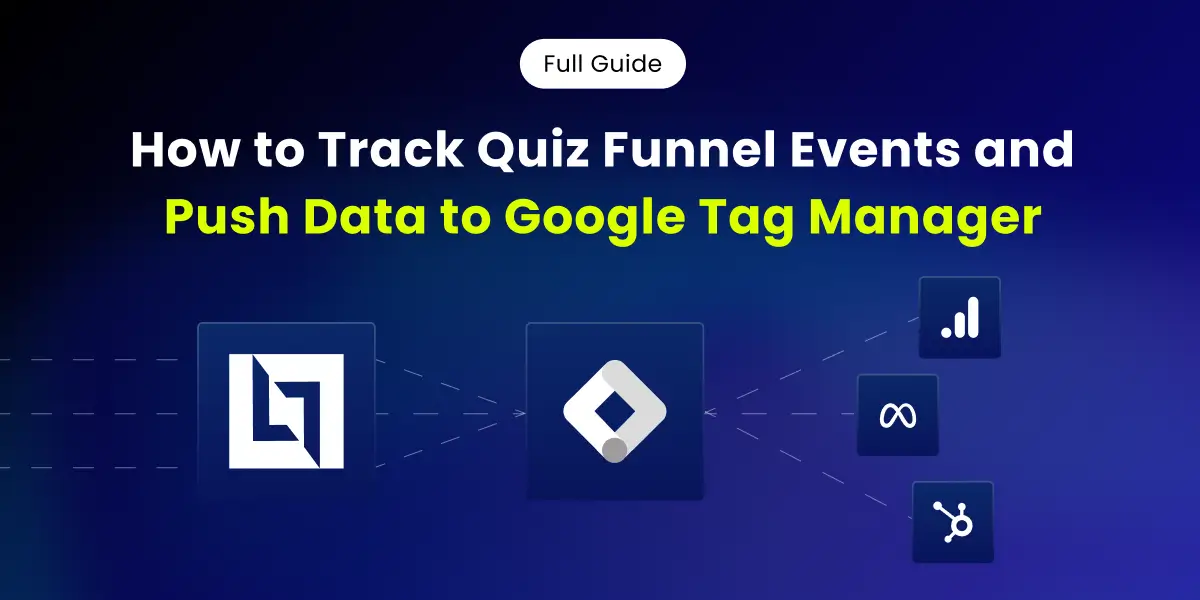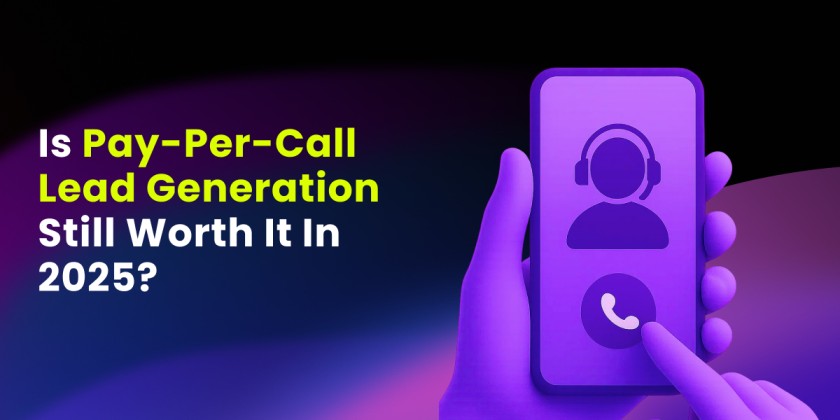Thousands of dollars. That’s how much money a company can lose every month if their landing page conversion rate is below the industry average. Every visitor that bounces represents real dollars walking away.
But here’s what’s fascinating: a competitor in the same niche who is selling a similar product at a higher price point can get nearly double or triple the industry average.
This happens often, and you know it, right? In fact, you can be the other company, earning so much less than you potentially can.
But the secret of the more successful company isn’t a bigger budget or fancier landing page design. It’s understanding exactly what makes landing pages convert.
The truth about landing page conversion rates will probably surprise you. In some industries, top performers are hitting 30-40% conversion rates, while others struggle to break 1%. Not all landing pages convert the same way. It all depends on your industry, where your traffic comes from, and the type of page you’re using. On average a landing page conversion rate sits around 5.89%, but the best pages are pulling in 3 to 5 times more conversions and that’s no accident.
The difference often comes down to knowing three key things:
- Your actual numbers (most marketers track this wrong)
- What’s truly possible in your specific niche
- Which landing page optimization tactics actually move the needle
Let’s discover what’s possible with your landing pages.
Article Breakdown
- What Is Landing Page Conversion Rate?
- Why Tracking Landing Page Conversion Rates Matters
- What’s the Average Landing Page Conversion Rate in 2025?
- Benchmarks for Landing Page Conversion Rate
- How Can You Improve Your Landing Page Conversion Rate?
- Beyond the Numbers: Your Next Move
What Is Landing Page Conversion Rate?
A landing page conversion rate is the percentage of site visitors who complete a desired action on your landing page. It’s a useful metric that tells you how effectively your landing page converts. If you want to understand the key components that influence conversion rates, you need to know the anatomy of a landing page and understand how each element influences visitor behavior.
Breaking Down the Concept
At its core, a landing page conversion rate measures the relationship between two key numbers:
- The total number of people who visit your landing page
- The number of those visitors who complete your desired action
The “desired action” or conversion can vary significantly depending on your goals. It might be:
- Making a purchase
- Signing up for a newsletter
- Downloading an ebook or whitepaper
- Registering for a webinar
- Starting a free trial
- Filling out a contact form
- Scheduling a demo
How to Calculate Landing Page Conversion Rate
The formula for calculating your landing page conversion rate is easy enough:
Conversion Rate CR = (Number of Conversions ÷ Total Number of Visitors) × 100
Looks pretty easy, yes?
Now, let’s talk about calculation accuracy.
Basic Calculation Method
Before you compute your landing page conversion rate, you need to first define the time period. It could be daily, weekly, monthly, or quarterly. Whatever you choose, make sure you remain consistent.
You can start by choosing a period that matches your business cycles. For example, if conversion for you is a lead, and you contact new leads every week, then you can set your measurement period to be weekly.
Once you’ve set your timeframe, you’ll need two pieces of data:
- The total number of visitors to your landing page, which you can gather from your page analytics; and
- The number of successful conversions during that period.
For instance, if last week, 50 people converted out of 1,000 visitors, you calculate landing page conversion rate like this:
CR = (50 ÷ 1,000) × 100 = 5%
Advanced Calculation Considerations
As you become better in your tracking, you’ll want to segment your data for deeper insights.
Segment based on Traffic Source
Traffic sources play a crucial role in conversion performance. Your landing page might convert differently for visitors coming from:
- Organic search results
- Paid advertising campaigns
- Social media channels
- Email marketing efforts
Segment based on Conversion Type
Beyond traffic sources, modern landing pages often have multiple types of conversions happening simultaneously. Try to separate the computation of landing page conversion rate based on the conversion type.
Segment based on User Quality
User quality is another important factor to consider. Not all visitors are equally likely to convert, and some traffic might not represent genuine opportunities.
When analyzing your landing page conversion rate, consider:
- The quality of your traffic sources
- How long visitors stay on your page
- Whether they engage with your content
- If they match your target audience profile
These considerations help you move beyond basic calculations to understand the true effectiveness of your landing page in converting qualified prospects into valuable conversions.
Why Tracking Landing Page Conversion Rates Matters
How effective is your landing page in helping you get the results you want? What can the landing page conversion rate tell you about your digital marketing efforts?
Here’s why it’s crucial:
- Business Impact Assessment
Landing page conversion rate directly ties marketing efforts to business results. It also:
- Helps quantify return on investment (ROI) for campaigns
- Identifies which offers resonate with your audience
- Resource Optimization
It shows whether your traffic acquisition efforts are paying off, so you can:
- Allocate marketing budget more effectively
- Identify which landing pages need attention, improvement, or further testing
- Performance Benchmarking
Conversion rate data can help set realistic goals for future initiatives. It can serve as the starting point for your goals.
You can also use it as a clear metric to measure improvements. Did the changes you apply deliver better results or have the performance gone worse?
It also serves as a point of comparison across different marketing campaigns.
- Customer Understanding
One of the most important indications of landing page conversion rate is that it reveals how well you’re meeting visitor expectations.
Are you targeting the right audience? Is your value proposition compelling enough?
- Shows the Real Impact on Your Bottom Line
The difference between a poorly converting landing page and an improved one can be huge. For example, if your landing page gets 10,000 monthly visitors:
- A 2% conversion rate on Month 1 means 200 conversions;
- A 3% conversion rate on Month 2 means 300 conversions.
That 1% difference means you’ll get 100 additional conversions per month. If you made no changes to your traffic source and only on the landing page (or possibly the ad), then it means you received more conversions for the same cost!
As you can see, even small changes in your conversion rate can greatly impact your bottom line.
What’s the Average Landing Page Conversion Rate in 2025?
The global average landing page conversion rate hovers around 5.89%, but this figure tells only a small part of the story.
When marketers talk about “average” landing page conversion rates, they often miss a crucial point: context matters more than any single number.
Recent data from Wordstream reveals a striking distribution of the performance of landing pages:
- 25% of pages perform poorly, receiving below 1% conversion rate
- 40% have median performance of 2.35% conversion rate
- Top 25% of pages have 5.31% or higher
- Top 10% of pages have 11.45% or higher
What’s particularly noteworthy is that top performers aren’t just slightly better. They’re converting at rates 3-5 times higher than the average. This isn’t just an anomaly; it’s achievable across virtually every industry.
Typical landing page conversion rates depend on multiple factors:
- Your industry and niche
- The type of conversion you’re seeking
- Your target audience
- The traffic source
- Your offer’s value proposition
- The complexity of the conversion process
Benchmarks for Landing Page Conversion Rate
Conversion Rate Benchmark Based on Industry
Research from Ruler Analytics provides a detailed breakdown of conversion rates across various industries. Note that conversion is based on qualified leads.
Professional Services leads the pack with a 4.6% average conversion rate, while B2B Ecommerce sees a more modest 1.8%. Here’s the complete breakdown:

- agency – 2.3%
- auto – 3.7%
- b2b ecommerce – 1.8%
- b2b tech – 2.7%
- b2c – 2.1%
- dental and cosmetic – 3.1%
- finance – 3.1%
- healthcare – 3.0%
- industrial – 4.0%
- legal – 3.4%
- professional services – 4.6%
- real estate – 2.4%
- travel – 2.4%
This data reveals some interesting patterns. Industrial and Professional Services sectors tend to see higher conversion rates, potentially due to their more targeted audience and higher-value propositions.
Meanwhile, B2B Ecommerce and B2C generally show lower rates, likely due to more competitive markets and less qualified traffic.
However, within each industry, top performers often achieve rates two to three times higher than these averages. For instance, while the average ecommerce conversion rate sits at 2.5-3.5%, leading companies in this space regularly see rates of 10-15%.
Landing Page Conversion Rate Benchmark Based on Traffic Source
Landing page conversion rates vary significantly depending on how visitors find your page. Here’s a detailed breakdown of performance across major traffic channels:
Social Media (1.5% average)
While social media shows lower conversion rates, it remains a critical channel for brand awareness and engagement. The performance varies dramatically across industries, suggesting the need for highly targeted and platform-specific strategies.
- Healthcare leads with 3.0%
- Travel and tourism achieves 2.7%
- B2B services reach 2.4%
- Lower rates in B2C services (0.1%) and B2B ecommerce (0.4%)
- Recent privacy changes have made tracking more challenging
Source: Ruler Analytics
And there’s alsosome major differences based on social network.
Facebook Ads, for instance, shows remarkably different patterns across industries, with an average conversion rate of 9.21% across all sectors. Note that this is when using Facebook ads to send traffic to the landing page, and not by using their lead gen objective, which doesn’t take the user out of Facebook.
Some industries see exceptional performance through this channel. Fitness, Education, Employment, Healthcare, Real Estate, and B2B dominate.
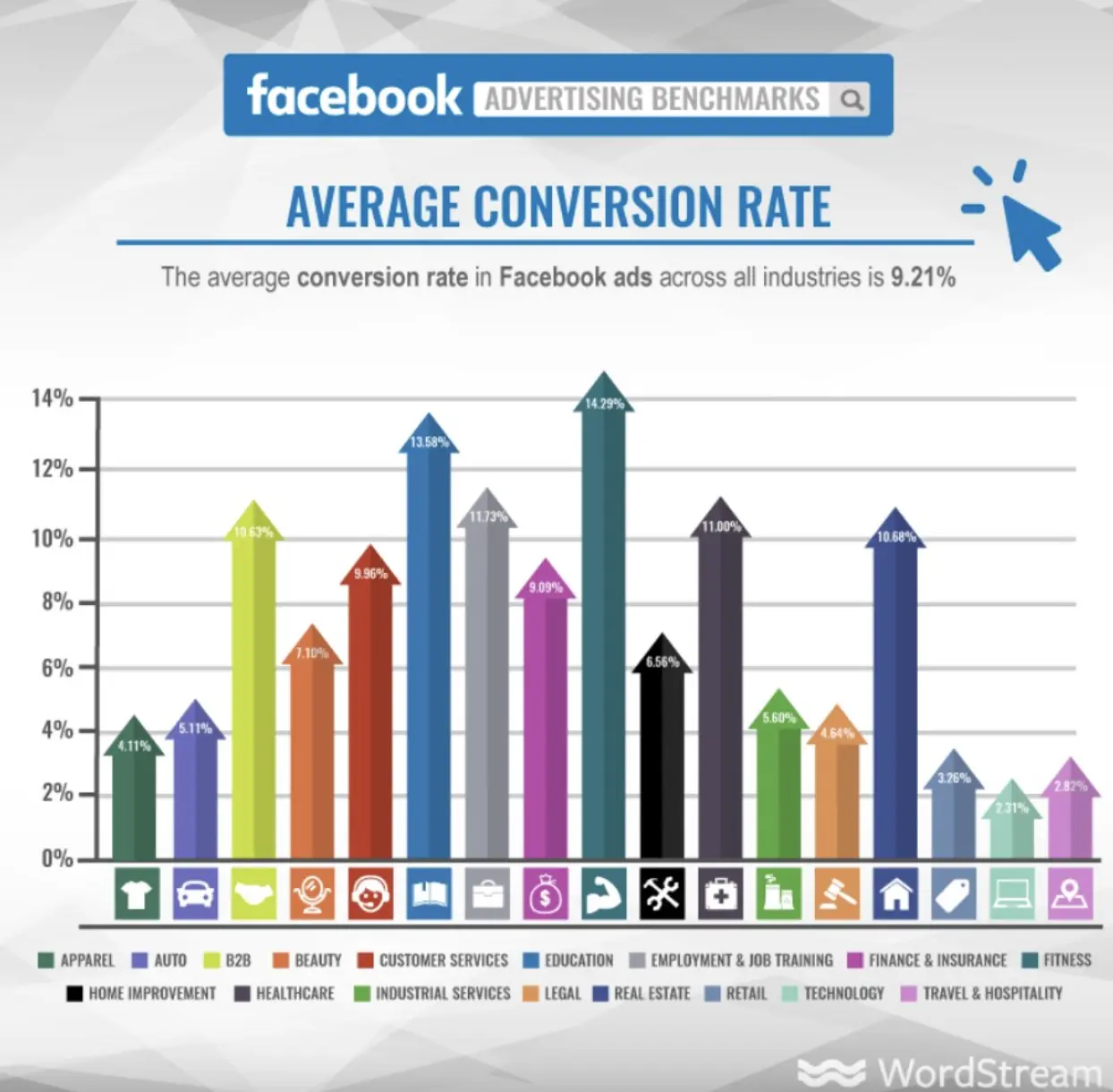
However, not all industries find the same success with Facebook Ads. Some sectors see significantly lower conversion rates, like Technology, Travel, and Retail.
This variance highlights why it’s crucial to benchmark against conversion rates specific to your traffic source and industry. For instance, while retail might see lower conversion rates on Facebook Ads, they often perform better through other channels.
Organic Search Traffic (2.7% average)
Professional services and industrial sectors excel in organic search, leveraging their expertise and targeted content to attract high-quality leads.
The relatively lower conversion rates in some industries suggest the need for more refined SEO and content strategies that directly address potential customers’ specific pain points.
Some key stats:
- Professional services and industrial sectors lead with rates of 5.0% and 4.4% respectively
- B2B services tend to perform better than B2C in organic search
- Healthcare and legal businesses see good results (2.4% and 3.0%)
- Lower rates seen in agencies (1.5%) and B2B ecommerce (1.5%)
- Success often correlates with search competitiveness in your niche
Paid Search (3.2% average)
Paid search reveals a nuanced landscape where targeted industries can achieve remarkable conversion rates. The variance suggests that success depends not just on the channel, but on the precise alignment of ads with user intent and the perceived value of the offering.
- Professional services and finance see the highest rates (5.0% and 5.2%)
- B2B tech and e-commerce show lower performance (1.5% and 1.7%)
- Industries with higher-value products tend to see lower conversion rates but higher value per conversion
- Healthcare averages 1.9% while automotive reaches 3.9%
Email Marketing (2.6% average)
Email marketing continues to prove its worth, especially for industries with more complex sales processes. The ability to nurture leads over time makes it a powerful tool for converting potential customers.
- Automotive and real estate lead with 3.9% and 3.5% respectively
- B2C services and agencies show lower rates around 0.9-1.9%
- Particularly effective for B2B with longer sales cycles
- Industrial sector achieves 2.9% while healthcare reaches 2.6%
Direct Traffic (3.3% average)
About 20% of overall traffic comes from direct sources, but it’s often hard to understand exactly where these visitors originate.
Key stats:
- Healthcare and dental sectors perform strongly (5.3%)
- Professional services average 2.7%
- Industrial businesses achieve 5.0%
- B2B tech shows lower rates at 1.5%
Direct traffic can be tricky to track. It includes visitors who type your website directly into their browser or come from sources that don’t pass referral information.
Plus, if the user has typed your landing page’s URL, chances are they’ve seen it before and they’re on the “purchasing” stage, so that creates variation as well.
Referral Traffic (2.9% average)
- B2B ecommerce performs strongly at 3.9%
- Dental and cosmetic services follow at 4.1%
- Financial services maintain 3.9%
- Travel shows lower rates at 1.0%
- Reviews and recommendations play a crucial role
Referral traffic underscores the importance of social proof and trusted recommendations. The significant variations across industries highlight how different sectors leverage word-of-mouth and professional networks.
Conversion Rate Benchmark Based on the Type of Landing Pages
Think your 5% conversion rate is good? It might be terrible… or it could be amazing. It all depends on what type of landing page you’re running.
Your industry isn’t the only thing that matters when it comes to conversion rates. The type of page you’re using can have an even bigger impact on your results. Here’s what you should really expect from each type of landing page:
Lead Generation Pages (9-12% Average)
Lead gen pages crush it compared to direct sales pages. Why? Because you’re asking for contact info, not credit card details. The commitment is lower, so conversion rates soar higher.
The best performers in this space hit 20-30% conversion rates through sophisticated optimization. Their winning formula includes:
- Dynamic forms that adapt based on user behavior
- Social proof that matches visitor demographics
- Targeted lead magnets for specific audience segments
Even average performers can nail 9-12% by getting the fundamentals right. The key is having a crystal-clear value proposition and keeping form fields minimal.
Most importantly, these pages succeed by perfectly matching their content to their target audience’s needs. They focus on delivering genuine value through their lead magnets, making the sign-up decision feel like a no-brainer for visitors.
Webinar Registration Pages (20-40% Average)
Want to see crazy-high conversion rates? Look at webinar pages. They regularly hit 20-40% because they nail four key conversion triggers:
- Urgency (the webinar happens on a specific date)
- Moderate commitment (just an hour of time)
- Clear value (learn X in 60 minutes)
- Social proof (learn from expert Y)
The real stars in this space reach 50-60% conversion rates by mastering the art of anticipation. They use live countdown timers to create urgency and showcase compelling speaker credentials that build trust.
These pages work because they make the value proposition crystal clear—specific knowledge or skills in exchange for a small time investment. The best ones remove all friction with one-click signup for returning visitors and clear, detailed agendas that get people excited about attending, just like X Business’s webinar landing page below.
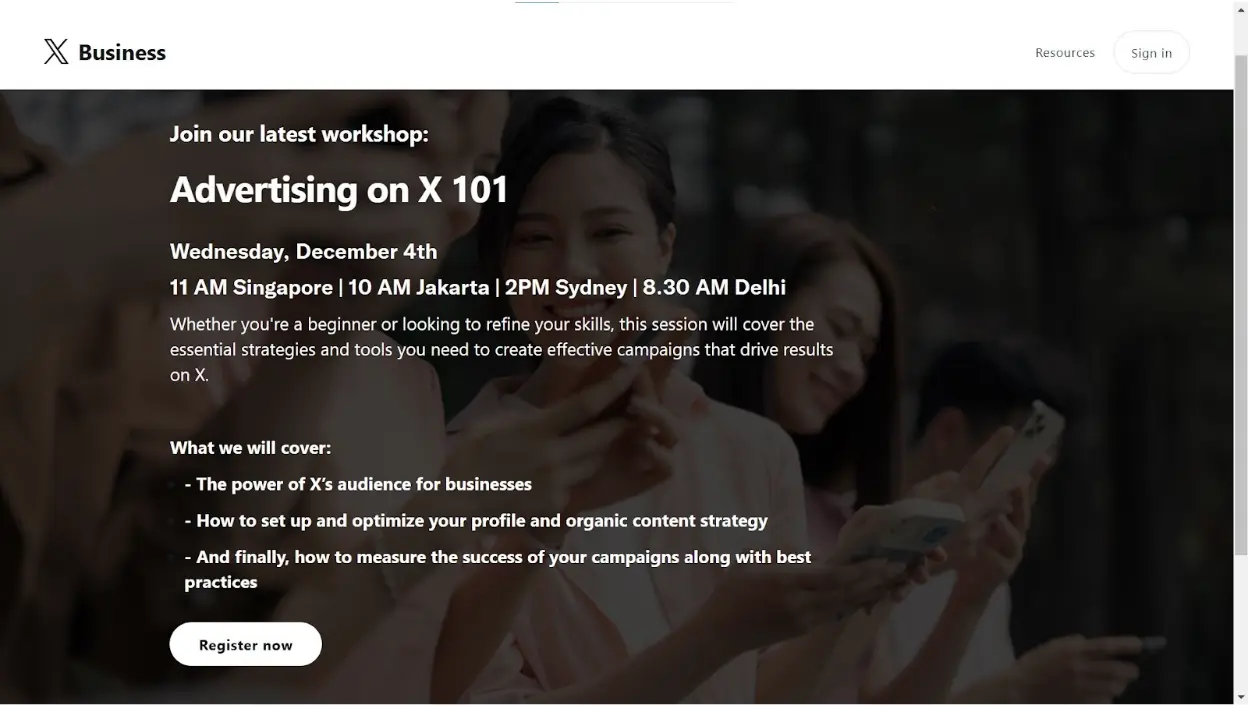
Product Pages (2-5% Average)
Product pages have it tough. They’re trying to convert cold traffic straight into sales. No wonder their conversion rates look low at first glance.
But here’s the thing: a 3% conversion rate on a $1,000 product beats a 15% rate on a $10 ebook any day.
Top product pages hitting 10-15% conversion rates win by making products irresistible through:
- 360° product views that let customers see everything
- Real customer photos and reviews front and center
- Live inventory updates creating natural urgency
- Smart pricing displays that encourage action
Your product page conversion rate depends heavily on several critical factors. Price point plays a huge role: higher prices typically mean lower conversion rates.
Product complexity matters too. The more complex your product, the more convincing your page needs to do. Then there’s market competition and purchase urgency to consider. The key is to start optimizing landing pages around these factors rather than chasing arbitrary benchmarks.
Newsletter Subscription Pages (10-20% Average)
Everyone and their grandmother has a newsletter these days. Standing out matters more than ever. But get it right, and you’ll see 10-20% of visitors hitting that subscribe button.
The newsletter champions hitting 30-40% conversion rates win by focusing on exclusivity and transparency. Their winning playbook includes:
- Offering content you can’t find anywhere else
- Showing off rave reviews from current subscribers
- Starting small (just email) then building engagement
- Letting visitors peek at past newsletters
Success comes from absolute clarity about your newsletter’s value. The best pages make their privacy policies straightforward and show sample content upfront, eliminating any uncertainty about what subscribers are signing up for. They focus on building trust first, then nurturing deeper engagement over time.
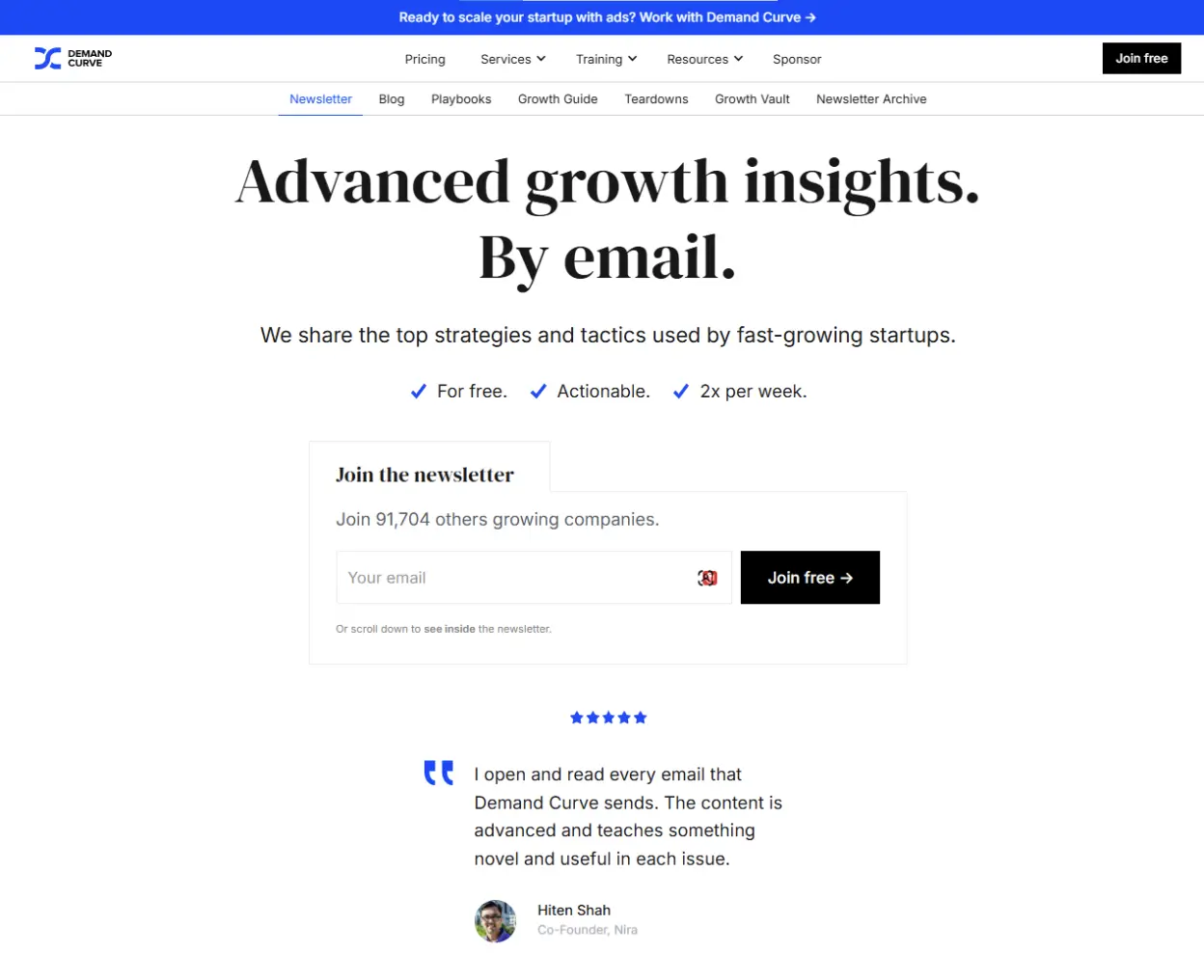
Free Trial Sign-Up Pages (5-15% Average)
Free trials walk the tightrope between lead gen and sales. You’re not asking for money (yet), but you’re asking for more commitment than just an email address. That’s why conversion rates typically land between 5-15%.
The heavy hitters reach 25-30% win by focusing on reducing friction at every step. Their high-converting pages emphasize:
- “No credit card required” messaging front and center
- Quick-start guides showing instant value
- Simple, streamlined onboarding process
- Reviews from free users who became customers
Your trial page’s success depends heavily on your offer structure. Consider how long the trial lasts and whether you require a credit card upfront. Think about which features to include and how to make getting started dead simple. The most successful pages nail these elements while making the path to value crystal clear.
Other Aspects that Have an Impact on Landing Page Conversion Rate
Geography
Regional differences play a crucial role in conversion rates. Markets with higher digital maturity often see different patterns than emerging markets.
Cultural differences, local competition, and market saturation all influence what constitutes a “good” conversion rate in different regions.
Device and Platform
User device and platform choices significantly impact landing page conversion rates. Data shows marked differences across platforms.
- Desktop conversion rates average 3.6% across industries
- Mobile conversion rates hover around 2.4%
- Tablet users convert at 3.1%
However, these numbers tell only part of the story. The conversion gap between devices often reflects user intent and context rather than inherent platform limitations.
Landing Page Speed
Remember the last time you clicked a link and stared at a loading screen? How long did you wait before hitting the back button? Your visitors are doing exactly the same thing.
Here’s something that might shock you: according to Portent, landing pages that load in less than one second convert at a jaw-dropping 31.79%.
That’s not a typo. Nearly one-third of visitors take action on the fastest pages. But wait until you see what happens when your page slows down…
Let’s break down the brutal truth about how speed affects your conversion rates:
- Lightning-fast (under 1 second): 31.79% conversion rate
- Pretty quick (1 second): 20.28%
- Getting slower (2 seconds): 13.93%
- Testing patience (5 seconds): A measly 9.68%
Why “Average” Shouldn’t Be Your Goal
If you’re achieving a 5% conversion rate, you might be doing better than 75% of advertisers. But you’re still leaving money on the table. The real opportunity lies in pushing beyond conventional benchmarks.
Focusing too much on average conversion rates can lead to misguided optimization efforts. A landing page converting at 3% might be performing exceptionally well if it’s:
- Operating in a highly competitive market
- Targeting a premium audience segment
- Seeking high-value conversions
- Converting qualified leads rather than general traffic
Conversely, a page converting at 8% might be underperforming if it’s:
- Working with warm, pre-qualified traffic
- Offering a low-commitment conversion
- Operating in a high-demand niche
- Targeting an easily converted audience segment
The key insight? Don’t let industry averages limit your ambitions.
The top performers in every sector prove that conversion rates two or three times the average aren’t just possible: they’re achievable with the right strategy. You should understand your specific context and set appropriate benchmarks based on your unique situation.
This is far more valuable than chasing industry averages. Just use the industry average as an initial reference, then adjust from there.
How Can You Improve Your Landing Page Conversion Rate?
Want to boost your landing page conversion rates? First, make sure you avoid making landing page mistakes that could be holding your conversions back. Here’s what actually works in 2025, based on real data and proven results:
1. Nail Your Message-to-Market Match
Don’t give visitors whiplash. If they click an ad about blue widgets, your landing page better talk about blue widgets. Period.
This isn’t just about matching words—it’s about maintaining the conversation your visitor thought they were starting.
The best-performing pages are consistent from ad to landing page. The headlines images, offers, and tone of voice all match. Using the right landing page images ensures visual consistency, reinforcing your message and keeping visitors engaged. Think of it as continuing a conversation rather than starting a new one.
2. Make Mobile Your Priority
In 2025, “mobile-friendly” doesn’t cut it anymore. Create landing pages that are mobile-first. The most successful mobile-optimized pages focus on these essentials:
- Forms that work perfectly with thumbs
- Load times under 2 seconds
- Click targets sized and spaced for fingers
- Zero horizontal scrolling needs
Beyond these basics, mobile success requires constant testing on real devices. Simulators won’t show you how your forms feel on a bumpy bus ride or how your page loads on spotty 4G. The difference between good and great mobile experiences often comes down to these real-world scenarios.
3. Build Trust Fast
Nobody converts on blind faith anymore, especially in 2025. Smart landing pages build trust through layered social proof that feels authentic and relevant.
Your trust-building arsenal should include:
- customer testimonials that match your visitor’s profile
- live conversion notifications that feel genuine, and
- trust badges that carry real weight in your industry.
Back everything up with case studies showing actual results and metrics. The key is authenticity. Savvy visitors can spot fake social proof from a mile away.
4. Simplify Your Forms
Every form field you add chips away at your conversion rate. The most successful landing pages only ask for absolutely essential information. They break longer forms into digestible steps and use auto-fill wherever possible.
When multi-step forms are necessary, they show clear progress bars and save partial entries for later completion. Most importantly, they make error messages helpful and friendly, not hostile or confusing.
5. Master Your Value Proposition
You’ve got mere seconds to capture attention and convince visitors to stay. A winning value proposition needs to answer these crucial questions:
- What’s in it for them?
- Why should they care?
- How are you different?
- Why act now?
The best pages don’t bury these answers in dense paragraphs. They make them impossible to miss with clear, compelling copy that speaks directly to your visitor’s needs and motivations.
Your value proposition should hit visitors like a bolt of lightning: immediate, powerful, and impossible to ignore.
6. Speed Up Everything
Slow loading pages are a conversion killer. The fastest-converting landing pages focus on systematic optimization and continual monitoring.
Implement lazy loading for below-the-fold content and leverage browser caching effectively. Every millisecond counts when it comes to keeping visitors engaged.
7. Test Smart, Not Hard
Focus your testing efforts on elements that actually move the needle. Test headlines that target different pain points.
Experiment with various lead magnet formats and value propositions. Try different approaches to social proof and guarantee statements. Test form layouts and steps that might reduce friction.
The key is testing elements that could change how visitors perceive and interact with your offer.
8. Use Scarcity (Without Being Sleazy)
Real scarcity drives action. Fake scarcity destroys trust. The winning approach includes:
- Actual inventory counts for limited products
- Genuine time limits on special offers
- True capacity constraints for services
- Real social proof of demand
The difference lies in authenticity. Your visitors can tell the difference between manufactured urgency and genuine scarcity. Focus on communicating real limitations honestly, and you’ll build both trust and conversions.
9. Optimize for Quality, Not Just Quantity
A high conversion rate means nothing if you’re attracting the wrong leads. Focus on qualifying visitors before they convert by setting clear expectations about your offer.
Be upfront about who your product or service isn’t for. Show pricing when relevant to filter out tire-kickers. Use self-selection tools that help visitors determine if they’re a good fit like their age range, marital status, gender, or other demographics that you use.
It’s not always about achieving high conversion rates, but high-quality conversions as well.
10. Make Your CTA Irresistible
Your call-to-action is where everything comes together. Make it crystal clear what happens when someone clicks. Be specific about what they’re getting and remove any hint of risk.
Use action-oriented language that compels clicks, and ensure your CTA is visible without scrolling. The best CTAs feel like a natural next step rather than a high-pressure sales pitch.
11. Track Beyond Basic Metrics
The most successful optimizers look beyond simple conversion rates. Their comprehensive tracking includes:
- Bounce rates by traffic source
- Time to first interaction
- Form abandon patterns
- Exit page hotspots
These deeper metrics often reveal optimization opportunities that basic conversion tracking misses. Pay special attention to how return visitors convert compared to first-time visitors. This often reveals your biggest improvement opportunities.
12. Personalize Thoughtfully
Effective personalization goes way beyond swapping out names in your copy. Consider your visitor’s traffic source, previous interactions with your brand, industry, company size, location, and even time of day.
Use this information to tailor your message and offer appropriately. But remember that good personalization feels natural and helpful, not creepy or invasive.
The key to improving landing page conversion rates isn’t following a template. It’s knowing your audience and consistently testing what works for them. Start with these proven strategies, but always test with your specific audience in mind.
Beyond the Numbers: Your Next Move
Here’s the truth about landing page conversion rates that most marketers won’t tell you: the numbers don’t matter as much as what you do next.
Stop obsessing over whether your 3.2% conversion rate beats the industry average. Instead, ask yourself one simple question: “What’s the smallest change I could make right now that would have the biggest impact on my results?”
Maybe it’s fixing that form that everyone abandons halfway through. Or perhaps it’s finally running that A/B landing page test you’ve been putting off. Whatever it is, do that thing first.
Remember this: every mega-successful landing page started somewhere. Netflix didn’t wake up one morning with a perfectly optimized sign-up flow. Shopify didn’t nail their free trial page on the first try. They started with basic pages and made them better, one test at a time.
Your landing page’s journey starts now. Pick one improvement from this guide— just one—and implement it today. Then come back after your initial test and pick another.
High-converting landing pages? It’s the one you’re about to create.
Ready to make those numbers climb?



